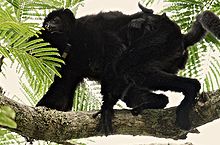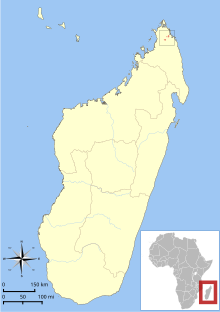| Perrier's sifaka | |
|---|---|

| |
| Scientific classification | |
| Domain: | Eukaryota |
| Kingdom: | Animalia |
| Phylum: | Chordata |
| Class: | Mammalia |
| Order: | Primates |
| Suborder: | Strepsirrhini |
| Family: | Indriidae |
| Genus: | Propithecus |
| Species: | P. perrieri
|
| Binomial name | |
| Propithecus perrieri | |

| |
| Distribution of P. perrieri[1] | |
Perrier's sifaka (Propithecus perrieri) is a lemur endemic to Madagascar. It was formerly considered to be a subspecies of diademed sifaka[4] It has a very small range in northeastern Madagascar where its habitat is dry deciduous or semihumid forest. Part of its range is in protected areas. It is an almost entirely black sifaka and measures about 90 cm (35 in), half of which is a bushy tail. Females are slightly larger than males.
It moves in small family groups through the canopy feeding on fruit, leaves, flowers, buds, and seeds. Groups have territories around one hectare and vocalise with each other. The main threats faced by this sifaka are habitat destruction and fragmentation due to slash-and-burn agriculture, charcoal gathering, and logging. The International Union for Conservation of Nature has rated its conservation status as "critically endangered".[5]
- ^ a b Heriniaina, R.; Hosnah, H.B.; Zaonarivelo, J. (2020). "Propithecus perrieri". IUCN Red List of Threatened Species. 2020: e.T18361A115573556. doi:10.2305/IUCN.UK.2020-2.RLTS.T18361A115573556.en. Retrieved 19 November 2021.
- ^ Cite error: The named reference
CITESwas invoked but never defined (see the help page). - ^ Groves, C. P. (2005). Wilson, D. E.; Reeder, D. M. (eds.). Mammal Species of the World: A Taxonomic and Geographic Reference (3rd ed.). Baltimore: Johns Hopkins University Press. ISBN 0-801-88221-4. OCLC 62265494.
- ^ Christoph Schwitzer; Olivier Arnoult; Berthe Rakotosamimanana. "An international conservation and research programme for Perrier's sifaka (Propithecus perrieri Lavauden, 1931) in northern Madagascar" (PDF). Lemur News Vol. 11, 2006. Lemur News. Retrieved 24 July 2012.
- ^ "IUCN".
